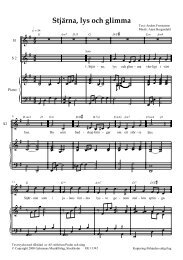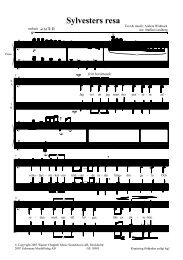Veli-Matti Puumala The music is the man - Gehrmans Musikförlag
Veli-Matti Puumala The music is the man - Gehrmans Musikförlag
Veli-Matti Puumala The music is the man - Gehrmans Musikförlag
You also want an ePaper? Increase the reach of your titles
YUMPU automatically turns print PDFs into web optimized ePapers that Google loves.
n o r d i c<br />
HIGHLIGHTS 3/2013<br />
N E W S L E T T E R F R O M G E H R M A N S M U S I K F Ö R L A G & F E N N I C A G E H R M A N<br />
<strong>The</strong> <strong>music</strong> <strong>is</strong> <strong>the</strong> <strong>man</strong><br />
Anders Eliasson 1947-2013<br />
<strong>Veli</strong>-<strong>Matti</strong> <strong>Puumala</strong><br />
– a master of time
N E W S<br />
Sibelius first edition<br />
Fennica Gehr<strong>man</strong> has publ<strong>is</strong>hed A <strong>The</strong>me<br />
and Variations for solo cello by Jean<br />
Sibelius. Th<strong>is</strong> <strong>is</strong> a first edition and has<br />
been edited by pian<strong>is</strong>t Folke Gräsbeck.<br />
Sibelius composed it in summer 1887,<br />
when he was 21, but it appears never to<br />
have been performed in public during h<strong>is</strong><br />
lifetime. It was first heard in a concert in<br />
Finland in 1995, and Torleif <strong>The</strong>déen<br />
recorded it for BIS <strong>the</strong> following year.<br />
Sibelius’s <strong>The</strong>me and Variations owes<br />
much to Bach in terms of its style, although<br />
<strong>the</strong> <strong>the</strong>me on which <strong>the</strong> variations are based<br />
has a certain Finn<strong>is</strong>h-Nordic flavour.<br />
Staern’s busy 2014<br />
Spring 2014 will see a number<br />
of Benjamin Staern premieres.<br />
He <strong>is</strong> just now composing Sånger<br />
om bländvit kärlek (Songs of<br />
Dazzlingly White Love), a song<br />
cycle to texts by Karin Boye, for alto<br />
Anna Larsson and <strong>the</strong> Helsingborg<br />
Symphony Orchestra, to be<br />
premiered on 14 April. It will<br />
be followed by <strong>the</strong> premiere of a<br />
work for chamber ensemble, live<br />
electronics, video, and real-time<br />
v<strong>is</strong>uals, at NorrlandsOperan in<br />
Umeå on 8 May. Conducted by<br />
Marc Soustrot <strong>the</strong> Malmö Symphony<br />
Orchestra will give <strong>the</strong><br />
world premiere of Godai –Concerto<br />
for Orchestra on 14 May.<br />
Next in turn <strong>is</strong> a 30-minute orchestral<br />
work, a comm<strong>is</strong>sion from<br />
<strong>the</strong> Royal Swed<strong>is</strong>h Academy of<br />
Music, for <strong>the</strong> Gävle, Helsingborg<br />
and Norrköping Symphony<br />
Orchestras.<br />
Photo: L<strong>is</strong>elotte Graversen<br />
Rautavaara’s All-night Vigil on TV<br />
<strong>The</strong> Helsinki Chamber Choir gave five perfor<strong>man</strong>ces of Einojuhani Rautavaara’s<br />
All-night Vigil during its September tour of Finland. <strong>The</strong><br />
Choir was conducted by Nils Schweckendiek and <strong>the</strong> solo<strong>is</strong>ts were Niall<br />
Chorell, tenor, and Jyrki Korhonen, bass. One of <strong>the</strong> concerts was filmed<br />
by Yle and will be shown on Finn<strong>is</strong>h TV on 5 October. In November<br />
<strong>the</strong>re will also be a TV broadcast by ARTE.<br />
<strong>The</strong> tour was a celebration of Rautavaara’s 85th birthday (9 October).<br />
Several orchestras will also be featuring works by him during <strong>the</strong> autumn. A<br />
birthday concert will also be given at <strong>the</strong> University of Oulu on 7 October.<br />
Two focus concerts in November<br />
In Helsinki <strong>the</strong>re are concerts presenting <strong>music</strong> by Lars Karlsson and<br />
Erik Berg<strong>man</strong>. Choral and chamber <strong>music</strong> and a song cycle with orchestral<br />
accompaniment by Karlsson will be heard at <strong>the</strong> Sibelius Academy<br />
on 8 November (See: premieres). <strong>The</strong> Helsinki Chamber Choir performs<br />
works by Berg<strong>man</strong> and enchantingly contrasts <strong>the</strong>m with ones<br />
by Gesualdo at a concert given on 17 November.<br />
Photo: Markku Pihlaja<br />
n o r d i c<br />
HIGHLIGHTS 3/2013<br />
NEWSLET TER FROM GEHRMANS MUSIKFÖRLAG & FENNICA GEHRMAN<br />
Sound samples , video clips<br />
and o<strong>the</strong>r material are available at<br />
www.gehr<strong>man</strong>s.se/highlights<br />
www.fennicagehr<strong>man</strong>.fi/highlights<br />
Cover photos: <strong>Veli</strong>-<strong>Matti</strong> <strong>Puumala</strong> (Music Finland/<br />
Saara Vuorjoki), Anders Eliasson (Tony Lund<strong>man</strong>),<br />
Helsinki Chamber Choir (Markku Pihlaja)<br />
Editors: Henna Salmela and Kr<strong>is</strong>tina Fryklöf<br />
Translations: Susan Sin<strong>is</strong>alo and Robert Carroll<br />
Design: Göran Lind<br />
ISSN 2000-2742 (Print), ISSN 2000-2750 (Online)<br />
Printed in Sweden by TMG Sthlm, Bromma 2013<br />
Heiniö & <strong>the</strong> Key Ensemble<br />
<strong>The</strong> Key Ensemble, one of Finland’s top vocal groups,<br />
has recorded two works by Mikko Heiniö. <strong>The</strong> M<strong>is</strong>sa<br />
Baltica d<strong>is</strong>c featuring h<strong>is</strong> Luceat has been well received<br />
abroad. Last year it was voted <strong>the</strong> best classical<br />
album in <strong>the</strong> Contemporary A Cappella Recording<br />
Award competition in <strong>the</strong> USA, and according to a<br />
Gramophone review, Heiniö’s Luceat <strong>is</strong> <strong>the</strong> real climax<br />
of <strong>the</strong> d<strong>is</strong>c. H<strong>is</strong> Maria Suite <strong>is</strong> one of <strong>the</strong> items on a<br />
new choral CD scheduled for release in October.<br />
<strong>The</strong> Key Ensemble conducted by Teemu<br />
Honkanen also performed works by Heiniö at festivals<br />
in Finland in summer 2013. In October, <strong>the</strong><br />
Ensemble will be singing in <strong>the</strong> finals of <strong>the</strong> 2013 Let<br />
<strong>the</strong> Peoples Sing competition.<br />
Photo: Jussi Vierimaa<br />
H i g h l i g h t s 3 / 2 0 1 3
Pettersson release in Norrköping<br />
Chr<strong>is</strong>tian Lindberg, <strong>the</strong> Norrköping Symphony Orchestra and BIS<br />
Records continue <strong>the</strong>ir promotion of Allan Pettersson’s <strong>music</strong>, with<br />
concert perfor<strong>man</strong>ces and recordings of Symphonies Nos. 4 and 16.<br />
In connection with <strong>the</strong> concert (31 Oct), <strong>the</strong> CD with Pettersson’s<br />
monumental Symphony No. 9, recorded in Norrköping last autumn,<br />
will be released toge<strong>the</strong>r with a bonus DVD including <strong>the</strong> Pettersson<br />
documentary “Männ<strong>is</strong>kans röst” (<strong>The</strong> Hu<strong>man</strong> Voice).<br />
Ville Matvejeff, Jorma Hynninen & Kimmo Hakola<br />
An autumn of Hakola stage works<br />
Works by Kimmo Hakola are being staged in several<br />
Finn<strong>is</strong>h towns during th<strong>is</strong> year. H<strong>is</strong> opera Akseli premiered<br />
in February 2013 has led to no fewer than six<br />
more perfor<strong>man</strong>ces during autumn: two at <strong>the</strong> Turku<br />
Music Festival, and <strong>the</strong> o<strong>the</strong>rs in Joensuu, Kuusamo<br />
and Hämeenlinna, and in Lahti in December. Akseli<br />
<strong>is</strong> a monologue opera and marks <strong>the</strong> operatic swansong<br />
of baritone Jorma Hynninen.<br />
Hakola’s children’s opera Mara and Katti <strong>is</strong> also in<br />
<strong>the</strong> autumn repertoire: Taite performed it in Espoo<br />
in August and <strong>the</strong>re were two perfor<strong>man</strong>ces at <strong>the</strong><br />
Tampere Hall in September.<br />
New comm<strong>is</strong>sions<br />
Rolf Martinsson will compose an opera in four acts<br />
based on Joseph Conrad’s short story Amy Foster.<br />
Stephen Plaice <strong>is</strong> writing <strong>the</strong> libretto (in Engl<strong>is</strong>h)<br />
to <strong>the</strong> opera, which <strong>is</strong> comm<strong>is</strong>sioned by <strong>the</strong> Royal<br />
Swed<strong>is</strong>h Opera in Stockholm.<br />
Tobias Broström has recently fin<strong>is</strong>hed h<strong>is</strong> String<br />
Quartet No. 1, comm<strong>is</strong>sioned by <strong>the</strong> New York based<br />
Brooklyn Rider. It will be premiered during <strong>the</strong>ir tour<br />
of Scandinavia in early 2014.<br />
Photo: Seilo R<strong>is</strong>timäki<br />
A Freak in Burbank receives<br />
six national premieres<br />
Albert Schnelzer’s concert opener A Freak in<br />
Burbank continues its advance throughout <strong>the</strong><br />
world with six national premieres from October till<br />
May 2014. Thomas Dausgaard will conduct <strong>the</strong><br />
work with <strong>the</strong> BBC Scott<strong>is</strong>h Symphony Orchestra<br />
in Glasgow and <strong>the</strong> French premiere with <strong>the</strong> Chamber<br />
Orchestra of Europe at Opera de Dijon. Stefan<br />
Solyom will lead Orchestra di Padova e del Veneto<br />
in <strong>the</strong> Italian premiere and Sinfonia Lahti in <strong>the</strong><br />
Finn<strong>is</strong>h premiere. Finally Mark Wigglesworth will<br />
direct <strong>the</strong> US premiere with <strong>the</strong> Utah Symphony<br />
Orchestra in Salt Lake City, as well as <strong>the</strong> Australian<br />
premiere with <strong>the</strong> Melbourne Symphony Orchestra.<br />
M<strong>is</strong>s Julie in Par<strong>is</strong><br />
Birgit Cullberg<br />
Opera National de Par<strong>is</strong> <strong>is</strong> staging <strong>the</strong> ballet M<strong>is</strong>s Julie<br />
in Birgit Cullberg’s classical choreography, to <strong>music</strong> by<br />
Ture Rangström (orchestrated by Hans Gross<strong>man</strong>).<br />
<strong>The</strong>re will be a total of 15 perfor<strong>man</strong>ces between 21<br />
February and 13 March 2014. Cullberg’s production of<br />
August Strindberg’s play <strong>is</strong> a harsh show down behind<br />
closed doors between an ar<strong>is</strong>tocratic young wo<strong>man</strong> and<br />
her servant, including both seduction and humiliation.<br />
<strong>The</strong> ballet had its premiere in 1950 and <strong>is</strong> reckoned as<br />
<strong>the</strong> first Swed<strong>is</strong>h modern dance drama.<br />
Photo: Ragnild Haarstad/Scanpix<br />
P r e m i e r e s<br />
Autumn 2013<br />
Sven-David Sandström<br />
Five Pieces for String Quintet<br />
Uppsala Chamber Solo<strong>is</strong>ts<br />
8.9. Uppsala, Sweden<br />
Four Pieces for String Quartet<br />
Stenhammar Quartet<br />
8.10. Stockholm, Sweden<br />
Olli Kortekangas<br />
Seven Songs for Planet Earth<br />
Tampere PO, Tampere Philharmonic Choir, San Franc<strong>is</strong>co<br />
Choral Society etc./Jani Sivén, sol. Tuija Knihtilä, mezzosoprano,<br />
Aarne Pelkonen, baritone<br />
13.9. Tampere, Finland (Finn<strong>is</strong>h premiere)<br />
Adventus (suite for organ),<br />
Five Chr<strong>is</strong>tmas Song Arrangements<br />
Tiina-Maija Koskela, soprano, Nicholas Söderlund, bassbaritone,<br />
Tuomas Tainio, percussion, Kari Vuola, organ<br />
8.12. Naantali, Finland<br />
<strong>Veli</strong>-<strong>Matti</strong> <strong>Puumala</strong><br />
Rime<br />
Ostrobothnian ChO/Tuomas Hannikainen<br />
20.9. Kokkola, Finland<br />
Johan Ullén<br />
Lady Macbeth<br />
Swed<strong>is</strong>h ChO/Gerard Korsten, sol. Katarina Karnéus,<br />
mezzo-soprano<br />
3.10. Örebro, Sweden<br />
Kimmo Hakola<br />
Music for <strong>the</strong> film Tukkijoella<br />
(Musiikkia elokuvaan Tukkijoella)<br />
Finn<strong>is</strong>h RSO/Santtu-Matias Rouvali<br />
11.10. Helsinki, Finland<br />
De kasp<strong>is</strong>ka tigrarnas Gud<br />
Chorus Sanctae Ceciliae<br />
22.11. Helsinki, Finland<br />
Jonas Valfridsson<br />
A Fragmented Memory, My Overgrown<br />
Little Tree House<br />
Jönköping Sinfonietta/Hannu Koivula<br />
27.10 Jönköping, Sweden<br />
Lars Karlsson<br />
Sju sånger till texter av Pär Lagerkv<strong>is</strong>t<br />
(Seven Songs to Texts by Pär Lagerkv<strong>is</strong>t)<br />
Wegelius String Orchestra/Arturo Alvarado,<br />
sol. Gabriel Suovanen, baritone<br />
8.11. Helsinki, Finland<br />
Kai Nieminen<br />
Symphony – La Selva<br />
Sinfonia Finlandia Jyväskylä/Patrick Gallo<strong>is</strong><br />
13.11. Jyväskylä, Finland<br />
Publ<strong>is</strong>hing agreement with Tiina Myllärinen<br />
Fennica Gehr<strong>man</strong> has signed a publ<strong>is</strong>hing agreement with Tiina Myllärinen for two orchestral works<br />
and her Squarcio for ensemble. Born in 1979, Myllärinen <strong>is</strong> a freelance composer working for a doctorate<br />
at <strong>the</strong> Sibelius Academy. She has composed orchestral, choral, chamber and solo works and experimented<br />
with electronic <strong>music</strong>. Outside Finland works by her have been performed in <strong>the</strong> United States,<br />
Italy, Ger<strong>man</strong>y, Lithuania, Iceland and Norway. Among those who have comm<strong>is</strong>sioned works from her<br />
are <strong>the</strong> Helsinki Chamber Choir, <strong>the</strong> Time of Music festival, <strong>the</strong> Polytech Choir (PK) and <strong>the</strong> “ja kitara<br />
soi” guitar festival. Myllärinen’s <strong>music</strong> has been described as cheerfully inqu<strong>is</strong>itive, vigorous and original.<br />
She has recently developed an interest in <strong>the</strong> application and study of various acoustic phenomena, such<br />
as resonance, in her <strong>music</strong>.<br />
Photo: Mika Kirsi<br />
H i g h l i g h t s 3 / 2 0 1 3
Composer <strong>Veli</strong>-<strong>Matti</strong> <strong>Puumala</strong><br />
(b. 1965), Professor at <strong>the</strong> Sibelius<br />
Academy and winner of <strong>the</strong> prestigious<br />
Finn<strong>is</strong>h Teosto Prize, has set out to alter<br />
our concept of time. In h<strong>is</strong> <strong>music</strong>, <strong>the</strong><br />
seconds measured by <strong>the</strong> clock fuse with<br />
an inner, empirical perception of time.<br />
Photo: Music Finland/Saara Vuorjoki<br />
<strong>Veli</strong>-<strong>Matti</strong> <strong>Puumala</strong><br />
– a master of time<br />
As one of h<strong>is</strong> pupils, I have been in a position to<br />
engage in some profound conversations with <strong>Veli</strong>-<br />
<strong>Matti</strong> <strong>Puumala</strong> on sometimes surpr<strong>is</strong>ing subjects.<br />
One day, for example, it was – ice-hockey. I had<br />
been sneering at Finland’s national sport in <strong>the</strong><br />
<strong>man</strong>ner of a true cultural snob when he looked at<br />
me and said: “Ice-hockey’s a fine game. It moulds<br />
your concept of time. Minutes can pass without<br />
anything really happening, and <strong>the</strong>n suddenly<br />
every thing <strong>is</strong> electrified for five seconds and someone<br />
scores a goal.”<br />
L<strong>is</strong>tening to <strong>Puumala</strong>’s <strong>music</strong> likew<strong>is</strong>e moulds<br />
our concept of time. At <strong>the</strong> most magical moments,<br />
time ceases to have any meaning, <strong>is</strong> transformed<br />
into a nocturnal fragrance as in <strong>the</strong> closing Tra le<br />
braccia della notte movement of h<strong>is</strong> piano concerto<br />
Seeds of Time .<br />
A concerto of <strong>man</strong>y dimensions<br />
Seeds of Time was born in 2004 as a joint comm<strong>is</strong>sion<br />
from <strong>the</strong> Oulu, Helsingborg, Sjaelland<br />
and Stavanger orchestras. Premiered with Swed<strong>is</strong>h<br />
virtuoso Roland Pöntinen as <strong>the</strong> solo<strong>is</strong>t, it was<br />
an immediate success and won <strong>Puumala</strong> <strong>the</strong> Teosto<br />
Prize for 2005. A large-scale work lasting 40 minutes,<br />
it poses no small challenge for its performers<br />
but its astounding originality makes it all <strong>the</strong> more<br />
rewarding.<br />
<strong>The</strong> <strong>music</strong>al motifs of th<strong>is</strong> concerto are drawn<br />
from <strong>the</strong> most varied of worlds: modern<strong>is</strong>tic filaments<br />
of sound, piano textures with a whiff of<br />
Ro<strong>man</strong> tic<strong>is</strong>m, even 1950s jazz. In <strong>Puumala</strong>’s case<br />
<strong>the</strong>se are not just styl<strong>is</strong>tic allusions; <strong>the</strong>y are a<br />
means of creating several superimposed concepts<br />
of time. Now and <strong>the</strong>n, as right at <strong>the</strong> beginning<br />
of <strong>the</strong> concerto, time comes to a complete halt in<br />
static “windows”. According to <strong>Puumala</strong>, <strong>the</strong>se<br />
afford a view of a different time that stands still<br />
and does not move.<br />
Ano<strong>the</strong>r thing that fascinates <strong>Puumala</strong> <strong>is</strong><br />
space. For <strong>man</strong>y of h<strong>is</strong> orchestral works, <strong>the</strong><br />
players can be placed unconventionally, thus<br />
gene rating new aural impressions. <strong>The</strong> chamber<br />
orchestra for Seeds of Time cons<strong>is</strong>ts of small<br />
groups of instruments from different families<br />
playing material that <strong>is</strong> to a greater or lesser degree<br />
uniform. For <strong>the</strong> perfor<strong>man</strong>ces conducted by<br />
Susanna Mälkki <strong>the</strong> players sat in small groups,<br />
whereas Hannu Lintu preferred a traditional<br />
seating arrangement. In o<strong>the</strong>r words, <strong>the</strong> conductor<br />
<strong>is</strong> free to choose.<br />
Timelessness in twelve minutes<br />
Mure (2008), composed for <strong>the</strong> Ensemble intercon<br />
temporain and Susanna Mälkki in 2008,<br />
divides <strong>the</strong> chamber orchestra into two groups.<br />
Again, superimposed time planes are what interest<br />
<strong>Puumala</strong>. <strong>The</strong> flowing runs in <strong>the</strong> “controlled<br />
chaos” of <strong>the</strong> opening section are counteracted by<br />
assertive comments from <strong>the</strong> brass and interjections<br />
evocative of hi-hat jazz. <strong>The</strong> <strong>music</strong> arrives<br />
at an unavoidable dead-end and a dramatic<br />
silence broken by two bass-drum beats. An e<strong>the</strong>real,<br />
<strong>Puumala</strong>-<strong>is</strong>h ep<strong>is</strong>ode <strong>the</strong>n follows in which all<br />
sense of time van<strong>is</strong>hes before stealthily returning<br />
to a more active world. For <strong>Puumala</strong>, <strong>the</strong> journey<br />
from time to timelessness <strong>is</strong> not impossible even in<br />
a work lasting only 12 minutes.<br />
Notwithstanding h<strong>is</strong> infinite attention to<br />
detail, <strong>Puumala</strong> also exploits <strong>the</strong> potential of a<br />
large orchestra. Rope, premiered by <strong>the</strong> Finn<strong>is</strong>h<br />
Radio Symphony Orchestra under Hannu<br />
Lintu in 2012, <strong>is</strong> scored for triple woodwinds,<br />
a large brass section, strings, and a big battery<br />
of percussion instruments complete with piano<br />
and harp. <strong>The</strong> title evokes images of tight-rope<br />
walking, but also of <strong>the</strong> sturdy ropes that fasten<br />
ships. Once <strong>the</strong> stormy swell has abated, string<br />
and brass waves shot with micro-intervals rock<br />
<strong>the</strong> boat like heavy rollers from a d<strong>is</strong>tant ocean.<br />
Delicate portraits of mourning<br />
Ever since <strong>the</strong> 1990s, <strong>the</strong> <strong>music</strong> of <strong>Puumala</strong> has<br />
often incorporated a modal element. <strong>The</strong> little<br />
town, Kaustinen, where he was born hosts a big<br />
folk <strong>music</strong> festival, and some may catch echoes of<br />
th<strong>is</strong> in h<strong>is</strong> modern<strong>is</strong>t idiom. Composed for <strong>the</strong><br />
Ostro bothnian Chamber Orchestra in 2008,<br />
Memorial Fragment breaks folk <strong>music</strong> elements<br />
down into <strong>the</strong>ir tiniest components. Little folkfiddle<br />
pieces float like motes into a void, where <strong>the</strong>y<br />
are d<strong>is</strong>torted into a delicate portrait of mourning.<br />
Scored for string orchestra, Memorial Fragment<br />
<strong>is</strong> a tribute to ano<strong>the</strong>r Kaustinen composer, Pehr<br />
Henrik Nordgren (1944–2008).<br />
One of <strong>the</strong> most recent works by <strong>Puumala</strong> <strong>is</strong><br />
Tear, premiered by <strong>the</strong> Tapiola Sinfonietta in<br />
March 2013. <strong>The</strong> name, he says, reflects tearing<br />
strands woven into thin, rough, rustling textures.<br />
It also calls to mind ano<strong>the</strong>r meaning of <strong>the</strong> word:<br />
deeply personal, tearful emotions. Players in <strong>the</strong><br />
medium-sized chamber orchestra are also singled<br />
out as solo<strong>is</strong>ts as <strong>the</strong> work proceeds.<br />
<strong>The</strong> line of orchestral compositions, starting<br />
with <strong>the</strong> early Tutta via (1993) and continuing<br />
with such works as Chainsprings (1995–<br />
1997) recently released on CD by Alba along<br />
with Seeds of Time, has seen some weighty additions<br />
in <strong>the</strong> past few years. <strong>Veli</strong>-<strong>Matti</strong> <strong>Puumala</strong><br />
has rapidly become one of <strong>the</strong> leading Finn<strong>is</strong>h<br />
composers of orchestral literature.<br />
L a u r i M ä n t y s a a r i<br />
Footnote:<br />
<strong>Puumala</strong>’s latest orchestral work Rime was premiered on<br />
20 September by <strong>the</strong> Ostrobothnian Chamber Orchestra<br />
and Tuomas Hannikainen.<br />
H i g h l i g h t s 3 / 2 0 1 23
<strong>The</strong> Swed<strong>is</strong>h composer Anders Eliasson<br />
passed away last spring after a protracted<br />
illness. It was not only h<strong>is</strong> native country<br />
that lost a great composer – but <strong>the</strong><br />
whole <strong>music</strong>al world.<br />
<strong>The</strong>re are actually very few composers who have<br />
been able to exhibit <strong>the</strong> same kind of intense proximity<br />
to <strong>music</strong>al creation as Eliasson. When <strong>the</strong><br />
often restless, expressive <strong>music</strong> comes surging up<br />
through <strong>the</strong> auditorium, Eliasson himself <strong>is</strong> present<br />
in every passage, h<strong>is</strong> breath <strong>is</strong> audible in every<br />
phrase. <strong>The</strong> <strong>music</strong> <strong>is</strong> <strong>the</strong> <strong>man</strong>.<br />
Eliasson’s <strong>music</strong> totally lacks <strong>the</strong> uneasy trendiness<br />
that <strong>the</strong> <strong>music</strong>al world <strong>is</strong> o<strong>the</strong>rw<strong>is</strong>e inundated<br />
with today – even <strong>the</strong> world of art <strong>music</strong>. In Eliasson’s<br />
compositions <strong>the</strong>re are no empty gestures,<br />
no stolen phrases, no imitating dialects, <strong>the</strong>re <strong>is</strong> no<br />
posturing.<br />
Nei<strong>the</strong>r did he himself put on airs, but throughout<br />
h<strong>is</strong> 66-year-long life he retained a sort of underdog<br />
position – <strong>the</strong> result of a painful childhood<br />
and a feeling of alienation, outside cliques and<br />
prevailing compositional ideas. It seems only logical<br />
that he, in a magnum opus such as <strong>the</strong> oratorio<br />
Dante Anarca, let <strong>the</strong> words “debellare superbos”<br />
(overthrow <strong>the</strong> haughty), grow to a crushing force<br />
in a grinding climax.<br />
“I want to flee into <strong>music</strong>”<br />
During our <strong>man</strong>y and lengthy conversations when<br />
I was working on my biography of Eliasson and<br />
h<strong>is</strong> <strong>music</strong>, he often stressed that he could not have<br />
survived without <strong>music</strong>; that he would hardly have<br />
reached adulthood. <strong>The</strong>se are words that might<br />
hint at sentimentality and a kind of ro<strong>man</strong>ticizing<br />
of <strong>the</strong> role of <strong>the</strong> art<strong>is</strong>t, but in h<strong>is</strong> personality<br />
<strong>the</strong>re was absolutely nothing of <strong>the</strong> sort. It was<br />
simply a matter of how he experienced it, literally.<br />
Music was h<strong>is</strong> life’s m<strong>is</strong>sion – something which<br />
perhaps contradicted ano<strong>the</strong>r opinion that he has<br />
expressed: “I should never have been born”.<br />
One can of course feel that Anders Eliasson <strong>is</strong><br />
entirely out of keeping with <strong>the</strong> times in h<strong>is</strong> sensitiveness,<br />
candour and seriousness. I believe, too,<br />
that th<strong>is</strong> <strong>is</strong> how he experienced it himself, as if he<br />
were a stranger among us. But in h<strong>is</strong> <strong>music</strong>al creativity<br />
he at <strong>the</strong> same time attained a refinement<br />
which resulted in h<strong>is</strong> <strong>music</strong>al “language” – formulated<br />
in freely floating harmony with two ninetone<br />
scales at bottom – serving as a kind of spiritual<br />
abode for him, in sharp contrast to <strong>the</strong> everyday<br />
toil. “I want to flee into <strong>music</strong>”, he said.<br />
<strong>The</strong> <strong>music</strong> angel<br />
Still, he claimed he was only <strong>music</strong>’s companion.<br />
H<strong>is</strong> subservience in respect to <strong>the</strong> essence of <strong>music</strong><br />
– “<strong>the</strong> <strong>music</strong> angel” as he called it – <strong>is</strong> perhaps hard<br />
to comprehend when it comes to such an obvious<br />
master as Anders Eliasson. “Music must be allowed<br />
to generate itself ”, he declared. It was as though he<br />
needed to have that perspective. He looked upon<br />
<strong>music</strong> as a friend and confidante, but h<strong>is</strong> respect<br />
for it seemed never<strong>the</strong>less to prevent him from, as<br />
Photo: Tony Lund<strong>man</strong><br />
<strong>The</strong> <strong>music</strong><br />
<strong>is</strong> <strong>the</strong> <strong>man</strong><br />
Anders Eliasson 1947-2013<br />
a simple hu<strong>man</strong> being, placing himself entirely on<br />
level with <strong>the</strong> wonders of <strong>music</strong>, that he even so<br />
was unquestionably capable of attaining. He spoke<br />
instead of being responsive and noting down <strong>the</strong><br />
<strong>music</strong>, with paper and pen, <strong>the</strong> moment that it<br />
emerged in h<strong>is</strong> inner being. It <strong>is</strong> indeed fantastic<br />
how, for example, h<strong>is</strong> very last work – <strong>the</strong> string<br />
trio Ahnungen, which he composed only with great<br />
difficulty during h<strong>is</strong> last year – exhibits <strong>the</strong> very<br />
same density and gushing power of expression that<br />
we find in h<strong>is</strong> o<strong>the</strong>r <strong>music</strong> – despite <strong>the</strong> <strong>man</strong>y and<br />
long interruptions caused by <strong>the</strong> cancer.<br />
Toward <strong>the</strong> end he was reconciled with <strong>the</strong> idea<br />
of dying. To be sure, he did want to compose <strong>the</strong><br />
5 th and 6 th symphonies, which were intended to<br />
form a kind of triptych toge<strong>the</strong>r with Symphony<br />
No. 4. <strong>The</strong> quiet epilogue of th<strong>is</strong> work, with a desolate,<br />
cantabile solo for flugelhorn, was <strong>the</strong> door that<br />
Music tips<br />
Ostacoli (1987) was written for <strong>the</strong> Ostrobothnian Chamber<br />
Orchestra. Th<strong>is</strong> <strong>is</strong> deeply moving, in places violently intense and<br />
nervy <strong>music</strong> for string orchestra. <strong>The</strong> work was <strong>the</strong> beginning of<br />
very fruitful relations with <strong>the</strong> Finn<strong>is</strong>h <strong>music</strong>al scene.<br />
Symphonies No. 1 (1986), No. 3 (1989) and No. 4 (2005) are all<br />
magnificent examples of works in <strong>the</strong> genre. From <strong>the</strong> tense and<br />
transparent atmospheres in Symphony No. 1 to <strong>the</strong> late Eliasson’s<br />
Symphony No. 4, <strong>the</strong>re <strong>is</strong> a development towards a softer flow and<br />
simplicity. Symphony No. 3 <strong>is</strong> a “sinfonia concertante” for obbligato<br />
alto saxophone; <strong>the</strong>re <strong>is</strong> also a version for soprano saxophone<br />
(2010) which has not yet been performed.<br />
slowly opened up to <strong>the</strong> next symphonic room.<br />
But death did not scare him. “It will be exciting<br />
to die”, he said more than once, often with an<br />
amusing smile and h<strong>is</strong> character<strong>is</strong>tically peering<br />
eyes. Of course, one might think that he said th<strong>is</strong><br />
to mitigate <strong>the</strong> anxiety of those closest to him, but<br />
I do believe that he honestly retained h<strong>is</strong> curiosity<br />
to h<strong>is</strong> very last breath, on that Monday evening <strong>the</strong><br />
20 th of May th<strong>is</strong> year.<br />
T o n y Lu n d m a n<br />
Author of <strong>the</strong> biography of Anders Eliasson (Bokförlaget<br />
Atlant<strong>is</strong>, 2012) and editor at <strong>the</strong> Stockholm Concert Hall<br />
Footnote:<br />
Eliasson’s very last work, <strong>the</strong> string trio Ahnungen, will<br />
be premiered by ZilliacusPerssonRaitinen on 10 February<br />
2014 at <strong>the</strong> Stockholm Concert Hall.<br />
Quartetto d’archi (1991) <strong>is</strong> one of Eliasson’s <strong>man</strong>y exqu<strong>is</strong>ite chamber<br />
works with a broad spectrum of expression, ranging from <strong>the</strong> forceful<br />
and belligerent to <strong>the</strong> sensual and cantabile.<br />
Dante Anarca (1998) <strong>is</strong> a mighty oratorio for soprano, contralto, tenor,<br />
baritone, mixed choir and orchestra, set to a text in Italian by Giacomo<br />
Oreglia. It <strong>is</strong> Eliasson’s magnum opus – an unm<strong>is</strong>takable masterpiece<br />
that <strong>is</strong> filled to <strong>the</strong> brim with passion, d<strong>is</strong>tinctive character and beauty.<br />
Concerto for Violin, Piano and Orchestra (2005) <strong>is</strong> a beautiful<br />
example from <strong>the</strong> <strong>man</strong>y solo concertos Eliasson wrote. Th<strong>is</strong> double<br />
concerto, with an unusual combination of solo<strong>is</strong>ts, <strong>is</strong> <strong>music</strong> full of<br />
dancing joie de vivre with supremely inspired orchestral elegance and<br />
balance.<br />
Photo: private<br />
Photo: Bo-Aje Melin/SVT/TT<br />
H i g h l i g h t s 3 / 2 0 1 3
R e p e r t o i r e t i p s<br />
R E V I E W S<br />
Wind and brass bands<br />
Kalevi Aho<br />
Concerto for Trumpet and Symphonic<br />
Wind Band (2011) Dur: 31’<br />
3333-4332-03-asax-tsax<br />
Th<strong>is</strong> concerto <strong>is</strong> suitable for perfor<strong>man</strong>ce<br />
at both wind band and symphony concerts. <strong>The</strong> first movement,<br />
in particular, includes singing, lyrical <strong>music</strong>. <strong>The</strong> quick<br />
second one has elements of jazz and <strong>is</strong> technically extremely<br />
difficult: <strong>the</strong> solo<strong>is</strong>t has to com<strong>man</strong>d such techniques as<br />
gl<strong>is</strong>sando, note inflection, lip trills and pedal notes. Towards<br />
<strong>the</strong> end, <strong>the</strong> concerto becomes more potent and dramatic,<br />
and it <strong>is</strong> <strong>the</strong>n that <strong>the</strong> solo part <strong>is</strong> most virtuosic.<br />
HUGO ALFVÉN<br />
Suite from <strong>the</strong> Mountain King<br />
(1923/2004) Dur: 22’<br />
Compilation and arr. Anders Högstedt<br />
3282-4432-13-1-ssax-asax-tsax-bsax-euph-2db<br />
<strong>The</strong> <strong>music</strong> to <strong>the</strong> ballet <strong>the</strong> Mountain King ranks among<br />
Hugo Alfvén’s finest works, with its folklor<strong>is</strong>tic motifs, enchanting<br />
mystic<strong>is</strong>m, nature lyric<strong>is</strong>m and drama. Th<strong>is</strong> suite<br />
contains seven depictive movements, including <strong>the</strong> frequently<br />
performed, whirling and rhythmically lively Herd<br />
Maiden’s Dance.<br />
DANIEL BÖRTZ<br />
Sinfonia 10 (1992) Dur: 17’<br />
3242-4442-14-0-4sax-euph<br />
Th<strong>is</strong> <strong>is</strong> a highly suggestive work that takes<br />
its point of departure in <strong>the</strong> very deepest<br />
darkness and silence, out of which a dull carpet of sound<br />
develops. It slowly works its way towards <strong>the</strong> light, while<br />
<strong>the</strong> rumbling bass drums create an almost fateful atmosphere.<br />
<strong>The</strong> middle part <strong>is</strong> more airily orchestrated, with<br />
quick, rhythmical figures in <strong>the</strong> winds. <strong>The</strong> drums drive<br />
<strong>the</strong> <strong>music</strong> forward, ending up in a powerful section for<br />
percussion ensemble, after which <strong>the</strong> dark timbres and<br />
<strong>the</strong> solemn mood from <strong>the</strong> beginning of <strong>the</strong> work return.<br />
Mikko Heiniö<br />
Sonata da chiesa (2005) Dur: 16’<br />
0000-4331-13-cel<br />
<strong>The</strong> form of <strong>the</strong> Sonata da chiesa points<br />
to a Baroque church sonata, but instead<br />
of being traditional <strong>music</strong> for <strong>the</strong> church, it paints glorious<br />
v<strong>is</strong>ions in sound. <strong>The</strong> movements are marked off by intermezzos<br />
in which <strong>the</strong> celesta occupies a focal role. <strong>The</strong> critics<br />
pra<strong>is</strong>ed <strong>the</strong> sensual timbres of th<strong>is</strong> work along with <strong>the</strong><br />
delicious rhythmic romping, for <strong>the</strong> second movement of<br />
<strong>the</strong> Church Sonata <strong>is</strong> real swinging boogie.<br />
FREDRIK HÖGBERG<br />
Troll Tuba – <strong>The</strong> Three Billy Goats Gruff<br />
(2005) Dur: 10’<br />
for tuba and symphonic wind band<br />
(text in Engl<strong>is</strong>h/Swed<strong>is</strong>h/Norwegian)<br />
3252-4431-13-0-2asx-tsax-bsax-euph-db<br />
Th<strong>is</strong> <strong>is</strong> an entertaining tuba concerto and <strong>music</strong>al tale<br />
in which <strong>the</strong> tuba player functions as both narrator and<br />
solo<strong>is</strong>t, and <strong>the</strong> orchestra <strong>music</strong>ians comment on <strong>the</strong> course<br />
of events. Here Högberg exhibits once again humour and<br />
lively <strong>music</strong>ianship with h<strong>is</strong> spirited, rhythmically vivacious<br />
and diverting <strong>music</strong>.<br />
Jukka Linkola<br />
Euphonium Concerto (1996) Dur: 29’<br />
Version for concert band arr. Elias Seppälä<br />
3262-4432-02-pf/cel-asax-tsax-bsax-euph-db<br />
Th<strong>is</strong> popular work, described by its composer<br />
as “unashamedly melodic”, abounds in technical challenges<br />
and <strong>music</strong>al brilliance. Linkola set out to exploit <strong>the</strong><br />
singing, sensual quality of h<strong>is</strong> solo instrument as a sensitive<br />
interpreter of melody. According to a review by Iwan Fox, th<strong>is</strong><br />
concerto <strong>is</strong> regarded as <strong>the</strong> “Everest” of its genre, tackled by<br />
<strong>man</strong>y, conquered by few.<br />
Pasi Lyytikäinen<br />
Necto (2010) Dur: 5’<br />
3322-4431-01-db<br />
Scored for symphonic winds, Necto was<br />
premiered by <strong>the</strong> Guards’ Band in October<br />
2010. It was originally intended as a bridge between<br />
Stravinsky’s Piano Concerto and Mussorgsky’s Pictures at<br />
an Exhibition; in th<strong>is</strong> respect it well serves its purpose,<br />
capturing <strong>the</strong> spirit of both. But <strong>the</strong> allusion to <strong>the</strong>m <strong>is</strong> so<br />
d<strong>is</strong>creet that Necto can also be performed as a separate<br />
concert number.<br />
HILDING ROSENBERG<br />
Symphony for Wind and Percussion –<br />
<strong>The</strong> Tower of Babel (1966) Dur: 18’<br />
2222-0330-13-0<br />
When Hilding Rosenberg composed <strong>the</strong><br />
<strong>music</strong> to Birgit Culberg’s ballet <strong>The</strong> Tower of Babel he wrote<br />
it in such a way that, with minimal changes, it could be converted<br />
into a concert work. And th<strong>is</strong> masterly written, captivating<br />
symphony has become something of a classic among<br />
Swed<strong>is</strong>h works for wind orchestra.<br />
Aul<strong>is</strong> Sallinen<br />
Chorali for Wind Orchestra (1970) Dur: 12’<br />
4444-6442-03-hp-cel<br />
According to composer Mikko Heiniö,<br />
Chorali has features that recall late Sibelius:<br />
melancholy, expressionless tones shunning all forms of<br />
colour<strong>is</strong>m, modal or whole-tone motion and above all <strong>the</strong><br />
orchestration. Chorali opens with a r<strong>is</strong>ing scale over solemn<br />
pedal notes. <strong>The</strong> mood <strong>is</strong> statically devout and chorale-like,<br />
but builds up to powerful drama in around <strong>the</strong> middle. <strong>The</strong><br />
last of its four motifs culminates in an ep<strong>is</strong>ode remin<strong>is</strong>cent<br />
of a funeral march.<br />
ALBERT SCHNELZER<br />
Azraeel Suite (2008) Dur: 13’<br />
2151-3432-11-0-asax-tsax-euph-db<br />
Schnelzer’s imaginative suite in three<br />
movements was inspired by Sal<strong>man</strong><br />
Rushdie’s <strong>The</strong> Satanic Verses. <strong>The</strong> two outer movements,<br />
(I. Burning of Books, and III. Angel of Death), are highly<br />
dramatic with considerable dynamic fluctuations, and<br />
violently driving rhythms, creating a feeling of impending<br />
threat. <strong>The</strong> <strong>music</strong> of <strong>the</strong> lighter middle movement, (“turn<br />
<strong>the</strong>m into instruments…”), <strong>is</strong> remin<strong>is</strong>cent of <strong>music</strong> from<br />
<strong>the</strong> Balkans, with its dancing rhythms, alternating between<br />
7/8 and 6/8 time.<br />
Profound, radiant works<br />
Rautavaara’s inimitable, intimately radiant o<strong>the</strong>r-worldliness<br />
<strong>is</strong> brilliantly matched by <strong>the</strong> rich timbres of a choir,<br />
and <strong>the</strong> singers’ charged and passionate dedication<br />
spins ideal interpretations of Rautavaara’s sacred works.<br />
Rondo, September 2013<br />
Einojuhani Rautavaara: Sacred Choral Works<br />
CD: Latvian Radio Choir/Sigvards Klava (Ondine ODE 1223-2)<br />
Aho’s oboe <strong>music</strong><br />
– exotic and stimulating<br />
Th<strong>is</strong> <strong>is</strong> really fascinating <strong>music</strong>…Bockstal captures<br />
<strong>the</strong> <strong>music</strong>’s grander sentiments marvelously...Th<strong>is</strong> <strong>is</strong><br />
an excellent collaboration and would be an appropriate<br />
addition to anyone’s collection who <strong>is</strong> seeking<br />
where <strong>the</strong> world of <strong>music</strong> and we are headed.<br />
American Record Guide July/August 2013<br />
Kalevi Aho: Works for <strong>the</strong> Oboe (Concerto for Oboe<br />
and Orchestra, Solo IX, Sonata for Oboe and Piano)<br />
CD: Lahti SO/Martyn Brabbins, sol. Piet Van Bockstal, Yutaka Oya,<br />
piano (BIS-SCD 1876)<br />
One of <strong>the</strong> most interesting composers<br />
Composer-guitar<strong>is</strong>t Kai Nieminen <strong>is</strong> quite definitely<br />
one of our most interesting contemporary composers,<br />
transforming h<strong>is</strong> impressions into <strong>the</strong> most<br />
fantastic compositions for various instruments<br />
and line-ups…Th<strong>is</strong> was <strong>the</strong> Finn<strong>is</strong>h premiere of h<strong>is</strong><br />
four-movement A Walk to <strong>the</strong> Mysterious Woods [for<br />
guitar]... It really <strong>is</strong> a walk to mysterious woods full of<br />
dazzling details.<br />
Valkeakosken Sanomat 3. & 5.7.<br />
Works by Kai Nieminen<br />
Trio La Rue, Patrik Kleemola, guitar etc., 3.9.2013 Sääksmäki, Finland<br />
Amazing Schnelzer<br />
Th<strong>is</strong> [Into Thin Air] <strong>is</strong> amazing<br />
<strong>music</strong>, with a wealth of contrasts<br />
and breakneck turns.<br />
Mårtensson’s playing made<br />
<strong>the</strong> clarinet stand out as<br />
<strong>the</strong> optimal instrument<br />
for th<strong>is</strong> type of expressivity.<br />
In Wolfgang <strong>is</strong> Dancing,<br />
Schnelzer poked fun at<br />
Mozart in imaginative and<br />
Staffan Mårtensson<br />
humorous <strong>music</strong> with a driving rhythm. <strong>The</strong> audience<br />
responded with a well-deserved ovation.<br />
Corren 15.8.<br />
Albert Schnelzer: Into Thin Air, Wolfgang <strong>is</strong> Dancing<br />
World premiere: Staffan Mårtensson, clarinet, Love Derwinger,<br />
piano, Erik Wahlgren, cello, Tobias Ringborg, violin, 14.8.2013<br />
Linköping Chamber Music Festival, Sweden<br />
Photo: Heikki Tuuli<br />
Photo: Carl Thorborg<br />
H i g h l i g h t s 3 / 2 0 1 3
Intoxicating piano concerto<br />
Here melodies flow in and out of one ano<strong>the</strong>r, forged<br />
ra<strong>the</strong>r than composed, in an intoxicating torrent.<br />
Both <strong>the</strong> orchestra and solo<strong>is</strong>t had great fun with <strong>the</strong><br />
material. <strong>The</strong> audience was left breathless.<br />
Helsingborgs Dagblad 13.8.<br />
Tobias Broström: Piano Concerto – Belle époque<br />
Musica Vitae/Fredrik Burstedt, sol. Per Tengstrand, 12.8.2013<br />
Helsingborg, Sweden<br />
Heiniö’s Luceat – climax of <strong>the</strong> d<strong>is</strong>c<br />
<strong>The</strong> high points are mainly in <strong>the</strong> latter half, however,<br />
starting with Kokkonen’s marvelous five-span Laudatio<br />
Domini, a real modern classic. Mikko Heiniö’s Luceat<br />
receives its first recording here and it <strong>is</strong> <strong>the</strong> real<br />
climax of <strong>the</strong> d<strong>is</strong>c, not <strong>the</strong> Górecki. We should have<br />
more Heiniö on d<strong>is</strong>c.<br />
Gramophone 2013<br />
Mikko Heiniö: Luceat<br />
Joonas Kokkonen: Laudatio Domini etc.<br />
CD: Key Ensemble/Teemu Honkanen (Fuga-9302)<br />
Cleverly-constructed drama<br />
Syyskesän laulu (Late Summer Song) <strong>is</strong> a cleverlyconstructed<br />
drama…<strong>The</strong>re were lots of contrasts,<br />
and <strong>the</strong> peaks and valleys were tastefully measured<br />
out. <strong>The</strong> instrumentation was colourful, Heiniö’s<br />
idiom seems quite at home in Nummi’s texts…Essi<br />
Luttinen sang magnificently and entered strongly<br />
into <strong>the</strong> shifting moods.<br />
Turun Sanomat 16.7.<br />
Mikko Heiniö: Syyskesän laulu (version for mezzosoprano<br />
and orchestra)<br />
Refugium <strong>music</strong>um/Tuomas Rousi, sol. Essi Luttinen, 13.7.2013<br />
Turku, Finland<br />
Stage perfor<strong>man</strong>ce of Linjama’s church opera in Ossiach in 2010<br />
Music that brings out goose pimples<br />
Jyrki Linjama composes fine works for <strong>the</strong> church, in<br />
earnest… H<strong>is</strong> technical mastery and skilful crafting<br />
guarantee a multidimensional result that touches even<br />
<strong>the</strong> l<strong>is</strong>tener unfamiliar with <strong>the</strong> underlying structures.<br />
<strong>The</strong> beginning of th<strong>is</strong> modern lament <strong>is</strong> so sensitive it<br />
brings out goose pimples. [Finn<strong>is</strong>h Stabat Mater]<br />
<strong>The</strong> church opera Die Geburt des Täufers has a<br />
similar effect. It works well in a concert version, too,<br />
Eliasson’s urgent<br />
and timeless <strong>music</strong><br />
Th<strong>is</strong> <strong>is</strong> independent <strong>music</strong> that follows its own symphonic<br />
laws. <strong>The</strong> <strong>the</strong>mes develop organically, as if by<br />
<strong>the</strong>mselves… Eliasson was a master builder of form.<br />
Helsingin Sanomat 31.5.<br />
Th<strong>is</strong> perfor<strong>man</strong>ce was consummate… Storgårds´<br />
was an incomparable, penetrating and emotionally<br />
charged interpretation of <strong>the</strong> dramaturgically and<br />
<strong>the</strong>matically well-wrought work…Eliasson’s <strong>music</strong><br />
has an urgency and timelessness in its appeal and<br />
aes<strong>the</strong>tics that <strong>is</strong> hard to res<strong>is</strong>t, and <strong>the</strong> contexts<br />
grow forth with impeccable logic.<br />
Hufvudstadsbladet 31.5.<br />
Anders Eliasson: Symphony No. 4<br />
Finn<strong>is</strong>h premiere: Helsinki PhO/John Storgårds,<br />
29.5.2013 Helsinki, Finland<br />
because here again Linjama <strong>is</strong> aiming at moods, and<br />
illustrates <strong>the</strong> main events with h<strong>is</strong> <strong>music</strong>.<br />
Kotimaa 25.7.<br />
Jyrki Linjama: Finn<strong>is</strong>h Stabat Mater<br />
World premiere: Soli Deo Gloria/Juhani Lamminmäki, sol. Piia<br />
Komsi, Ulla Ra<strong>is</strong>kio, Ritva Ko<strong>is</strong>tinen, 29.6.2013 Kokkola, Finland<br />
Die Geburt des Täufers<br />
Concert version: Soli Deo Gloria/Juhani Lamminmäki,<br />
sol. Ursula Langmayr, Esa Ruuttunen etc., 7.7.2013 Espoo, Finland<br />
Fury and reconciliation<br />
in Sixten’s Requiem<br />
Here we encounter<br />
chaos, anger, tensions,<br />
wild frenzy – a surreal<strong>is</strong>tic<br />
and fluctuating reality.<br />
But Sixten’s <strong>music</strong> does<br />
not lose its foothold:<br />
penetrating and pure<br />
folk elements are also<br />
<strong>the</strong>re…“In parad<strong>is</strong>um” <strong>is</strong><br />
<strong>the</strong> loveliest of <strong>the</strong> movements,<br />
where <strong>the</strong> sufferer<br />
finally sees <strong>the</strong> light.<br />
Sundsvalls Tidning 28.6.<br />
Fredrik Sixten: Requiem<br />
CD: Swed<strong>is</strong>h Radio Choir, Nordic ChO/Ragnar Bohlin, sol. Karin<br />
Ingebäck, soprano, Anders Larsson, bass (Intim musik IMCD 120)<br />
Photo: Ferdinand Neumueller<br />
Photo: Anders Eliasson<br />
L<strong>is</strong>a Larsson and <strong>the</strong> Kreutzer Quartet<br />
Photo: Markus Palmgren, BLT<br />
Beautiful and expressive<br />
Martinsson songs<br />
<strong>The</strong> ten movements (Dickinson poems set to<br />
<strong>music</strong>) were character<strong>is</strong>ed by intense drama<br />
but also by small effects that provided a singular<br />
suspense and vitality….<strong>The</strong> most exciting<br />
of all was <strong>the</strong> premiere of Till skuggan av en<br />
verklighet, for soprano and string quartet. L<strong>is</strong>a<br />
Larsson’s soprano sounded so liberating, not<br />
only beautiful but also strong and expressive,<br />
with Karin Boye’s words about love, in vivid harmony<br />
with <strong>the</strong> outstanding Kreutzer Quartet.<br />
Blekinge Läns Tidning 5.7.<br />
Rolf Martinsson: Songs on Poems by Emily<br />
Dickinson (song/piano-version),<br />
Till skuggan av en verklighet<br />
World premiere: L<strong>is</strong>a Larsson, soprano, Roland Pöntinen,<br />
piano, Kreutzer Quartet, 4.7.2013 Lyckå Chamber Music<br />
Festival, Sweden<br />
Cinematic concert<br />
overture<br />
I very much liked <strong>the</strong> piece, a study in harmonic<br />
instability with an almost cinematic<br />
deployment of massive blocks of chords in<br />
<strong>the</strong> brass r<strong>is</strong>ing from and falling back into a<br />
sea of scurrying strings…<br />
Seen and Heard 31.5.<br />
Martinsson’s ten-minute piece was a brilliant<br />
opening for <strong>the</strong> concert…<strong>The</strong> work<br />
begins with grand, brassy fanfares and<br />
jazzy rhythms…followed by <strong>music</strong> as lushly<br />
ro<strong>man</strong>tic as Erich Korngold’s film scores…<br />
It’s an overture worth hearing again.<br />
bachtrack 31.5.<br />
Rolf Martinsson: Open Mind<br />
Cleveland SO/Manfred Honeck,<br />
26.5.2013 Cleveland, USA<br />
H i g h l i g h t s 3 / 2 0 1 3
n e w p u b l i c at i o n s<br />
C H O R A L<br />
Nils Lindberg<br />
Nu jublar min själ/My Heart Sings for Joy<br />
Version for mixed choir, trumpet and organ<br />
GE 12293<br />
Version for brass orchestra, percussion,<br />
mixed choir and double bass<br />
Text: Book of Psalms (Swe/Eng)<br />
GE 12257<br />
Chr<strong>is</strong>tian Engqu<strong>is</strong>t<br />
<strong>The</strong> D<strong>is</strong>tant Star<br />
for mixed choir<br />
Text: <strong>The</strong> composer (Eng)<br />
GE 12278<br />
Per Gunnar Petersson<br />
Sanctus<br />
for mixed choir<br />
Text: from Mass (Latin)<br />
GE 12284<br />
Anders Paulsson<br />
Heaven Come Down<br />
for mixed choir<br />
Text: Cecil Frances Alexander<br />
& Anders Paulsson (Eng)<br />
GE 12278<br />
Kjell Lönnå, arr.<br />
Pat-a-pan<br />
for descant choir<br />
Music & text: Bernard de<br />
La Monnoye<br />
(Fr/Eng)<br />
GE 12310<br />
Göran Arnberg<br />
Dormi Jesu<br />
for descant choir<br />
Text: Dutch 16th cent. (Latin)<br />
Transl: Samuel T. Coleridge (Eng)<br />
GE 12276<br />
N E W C D s & D V D s<br />
C H A M B E R & I N S T R U M E N T A L<br />
Kalevi Aho (arr.)<br />
Rimsky-Korsakov: <strong>The</strong> Flight<br />
of <strong>the</strong> Bumble Bee<br />
Residentie Orkest Den Haag/Neeme<br />
Järvi, sol. Sharon Bezaly<br />
BIS SACD 1679 (“Great Works for Flute<br />
and Orchestra”)<br />
TOBIAS BROSTRÖM<br />
Samsara, Dreamscape,<br />
Cello Concerto<br />
Västerås Sinfonietta & strings from<br />
Swed<strong>is</strong>h National Youth SO/Johannes<br />
Gustavsson, essens:1, Hugo Ticciati,<br />
violin, Johan Bridger, marimba,<br />
Mats Rondin cond. and cello<br />
dbCD154<br />
Paavo Heininen<br />
Quintet Op. 7,<br />
Saxophone Sonata<br />
Kimmo Kuitunen<br />
Leino meets ASQ<br />
Pasi Lyytikäinen<br />
Rosso<br />
Olli-Pekka Tuom<strong>is</strong>alo, saxophone,<br />
Hanna Kinnunen, flute, R<strong>is</strong>to-<strong>Matti</strong><br />
Marin piano etc.<br />
Pilfink Records JJVCD-123 (”Chambersax”)<br />
Olli Kortekangas<br />
Anna n<strong>is</strong>kasi niellä kynteni jälki<br />
Polytech Choir/Juha Kuivanen<br />
PKCD 23 (”Kuuletko sinä”)<br />
Einojuhani Rautavaara<br />
Sacred Choral Works<br />
Latvian Radio Choir/Sigvards Klava<br />
Ondine ODE 1223-2 (”M<strong>is</strong>sa a cappella”)<br />
Erkki Salmenhaara<br />
Canzonetta<br />
Ostrobothnian Chamber Orchestra/<br />
Juha Kangas<br />
Alba ABCD 355 (”Epifania”)<br />
FREDRIK SIXTEN<br />
Requiem<br />
Swed<strong>is</strong>h Radio Choir, Nordic ChO/<br />
Ragnar Bohlin, sol. Karin Ingebäck,<br />
Anders Larsson<br />
Intim musik IMCDS 120<br />
WILHELM STENHAMMAR<br />
String Quartets Nos. 3 & 4<br />
Stenhammar Quartet<br />
BIS-CD-1659<br />
EDUARD TUBIN<br />
Symphonies Nos. 2 & 5<br />
Estonian Radio SO/Peeter Lilje<br />
DVD 4742229 00434<br />
© International Tubin Society<br />
ROLF MARTINSSON<br />
Capriccio<br />
for solo violin<br />
GE 10994<br />
Einojuhani Rautavaara<br />
Hymnus<br />
for trumpet and organ<br />
FG 55009-947-0<br />
SVEN-DAVID SANDSTRÖM<br />
Dance III<br />
for three violoncelli<br />
GE 12355<br />
O R C H E S T R A L<br />
FREDRIK HÖGBERG<br />
Ice Concerto<br />
for piano and orchestra<br />
GE 12203 (score)<br />
Ahti Sonninen (arr.)<br />
Cantate cantica socii<br />
for string orchestra<br />
A set of parts (333221)<br />
<strong>is</strong> now available for sale.<br />
FG 55011-153-0<br />
Jean Sibelius<br />
<strong>The</strong>me and Variations<br />
(Teema ja variaatiot)<br />
for solo cello<br />
FIRST PUBLICATION<br />
FG 55009-238-9<br />
Fredrik Sixten<br />
Toccata & Fugue<br />
on B-A-C-H<br />
for organ<br />
GE 12277<br />
V O C A L<br />
Kimmo Hakola<br />
Kivi-laulut (Kivi Songs)<br />
Seven Songs to Texts by Aleks<strong>is</strong> Kivi<br />
for voice and piano<br />
<strong>The</strong> songs ex<strong>is</strong>t also in orchestral<br />
versions.<br />
FG 55011-149-3<br />
For fur<strong>the</strong>r information about our works or representatives worldwide check our web sites or contact us at:<br />
H i g h l i g h t s 3 / 2 0 1 2<br />
Gehr<strong>man</strong>s Musikförlag AB<br />
Box 42026, SE-126 12 Stockholm, Sweden<br />
Tel. +46 8 610 06 00 • Fax +46 8 610 06 27<br />
www.gehr<strong>man</strong>s.se • info@gehr<strong>man</strong>s.se<br />
Hire: hire@gehr<strong>man</strong>s.se<br />
Web shop: www.gehr<strong>man</strong>s.se<br />
Sales: sales@gehr<strong>man</strong>s.se<br />
Fennica Gehr<strong>man</strong> Oy Ab<br />
PO Box 158, FI-00121 Helsinki, Finland<br />
Tel. +358 10 3871 220 • Fax +358 10 3871 221<br />
www.fennicagehr<strong>man</strong>.fi • info@fennicagehr<strong>man</strong>.fi<br />
Hire: hire@fennicagehr<strong>man</strong>.fi<br />
Web shop: www.fennicagehr<strong>man</strong>.fi<br />
Sales: kvtilaus@kirjavalitys.fi (dealers)


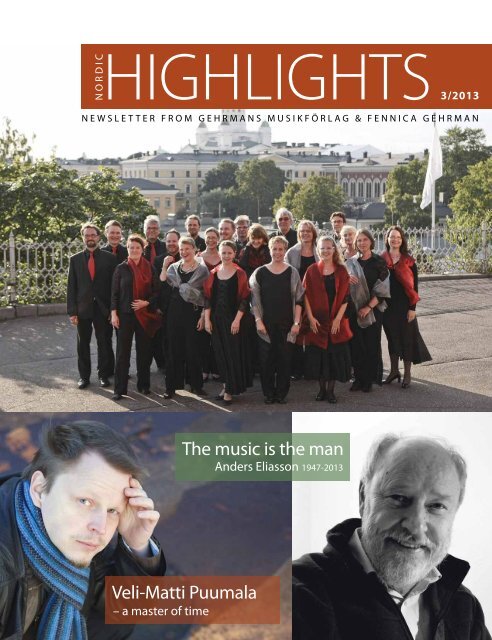
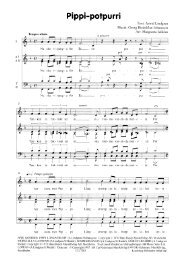

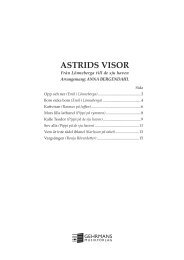
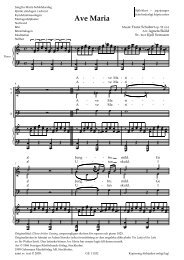





![Finale 2008a - [Lyssna, Gläd dig korr1.MUS] - Gehrmans Musikförlag](https://img.yumpu.com/38933790/1/184x260/finale-2008a-lyssna-glad-dig-korr1mus-gehrmans-musikfarlag.jpg?quality=85)
